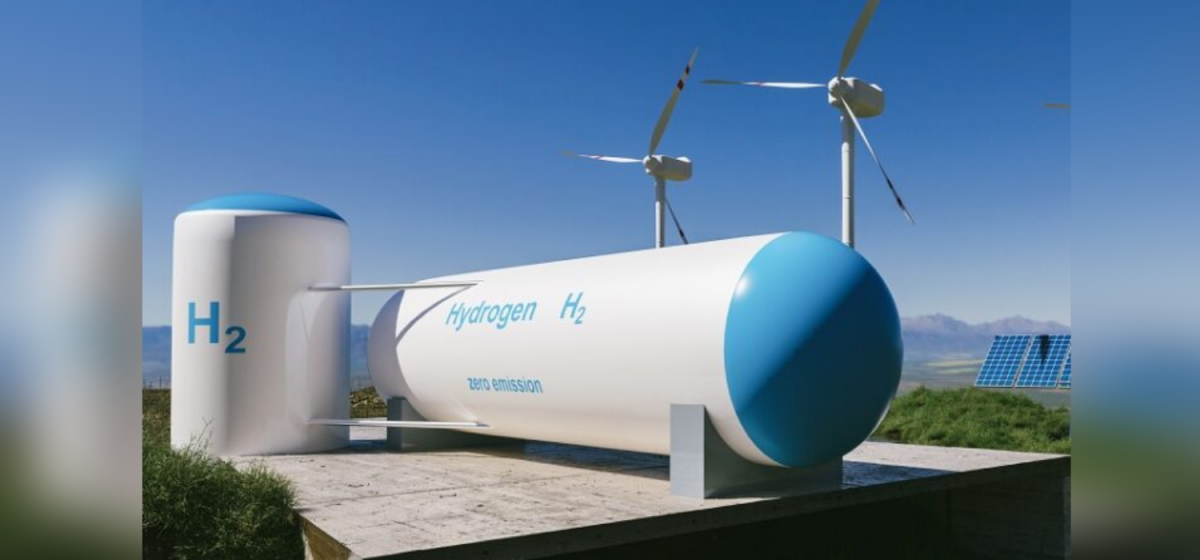Pritam Singh and Simon Pirani, writing in The Wire
There’s so much fanfare around green hydrogen in the ruling establishment and among clean energy hawks, but what is being missed is the problems associated with hydrogen being treated as an alternative to fossil fuels and the viability of the process involved in obtaining green hydrogen.

Representational image of a green hydrogen plant. Photo: Twitter.
Given the climate emergency our planet is facing, with accelerating global heating and devastating bio-diversity loss, any initiative by a government which proclaims its aim as ‘greening the economy’ deserves critical examination for both its importance and limitations.
Prime Minister Narendra Modi’s announcement on India’s 75th Independence Day of the government’s plan to launch a National Hydrogen Mission is one such initiative by an emerging economic power in the global economy. The mission was approved by Union Cabinet, chaired by Prime Minister Modi, on January 4 this year while earmarking Rs 19,744 crore as an initial investment.
Its stated purpose is to make India a production and export hub of green hydrogen. This stated aim is also believed to be part of India’s aim to reduce its reliance on oil from Russia and the Middle East – the need for which has become increasingly important after the start of the Russia-Ukraine conflict.
That hydrogen is a problematic green energy resource as an alternative to fossil fuels is not generally recognised. This obfuscation characterises the Indian government’s ‘green’ hydrogen mission too.
Different types of hydrogen
Hydrogen is the most abundant element in the universe, but for commercial use on the earth, it is produced either from fossil gas, usually by steam reformation, or by the electrolysis of water. Electrolysis technology splits hydrogen from oxygen in the water.
More than 98% of hydrogen used commercially is “grey” – produced from gas. Left-over carbon is joined with oxygen and released into the atmosphere as carbon dioxide. Global hydrogen production’s carbon footprint is about four-fifths the size of the aviation sector’s.
Gas companies claim they can produce “blue” hydrogen, without most of these emissions, by capturing and storing the carbon. But carbon capture and storage technology experimented with for about 40 years has never worked at a large scale.
“Green” hydrogen, produced by electrolysing water, is emissions-free but very energy-intensive. Wind and solar capacity one-and-a-half times the world’s current total would be needed to substitute the world economy’s “grey” hydrogen with “green”.
India’s plan
The government says it intends to focus on “green” hydrogen – a good approach in principle. However, as India decarbonises its economy, hydrogen may be needed, particularly to make fertilisers for agriculture, and for zero-carbon steel production.
But, we must face the fact that large amounts of solar and wind power would be needed, while India also needs those energy sources to reduce its dependence on coal. The burden on land and water resources also needs to be considered.
The viability of India’s Green Hydrogen Mission has also come into question because Adani’s business participation was a key driver. Adani announced a $50 billion hydrogen development project in partnership with TotalEnergies, the French oil and gas company.
TotalEnergies had hoped to take a 25% stake in an Adani subsidiary to focus on hydrogen. But in the wake of the crisis engulfing Adani’s business lately, TotalEnergies has stopped the project going forward.
Questions that need answering
We believe that questions need answering about the National Hydrogen Mission – about how it fits into India’s energy and climate policy more broadly; about the resources, it will use; and about what hydrogen will be used for in India.
Question 1: Will the vital task of cutting coal consumption be undermined, by focusing renewable electricity capacities on hydrogen?
The government proposes to produce 5 million tonnes/year of “green” hydrogen by 2030 – which would need about 120-125 gigawatts (GW) of renewable electricity generation capacity. That would mean more than doubling the amount of electricity generated in India from solar panels and wind farms – a herculean task.

Solar panels representational image. Photo: rawpixel.com/public domain/CC0 1.0.
It is critical to use these valuable resources wisely: each megawatt-hour used to make hydrogen will not be available for other purposes.
The number of solar panels and wind farms needed could, alternatively, supply as much electricity to the grid as 30-40 large (1.5 GW) coal-fired power stations. Such stations could then be retired. India could start cutting coal output, coal imports, and coal burning even before 2030. These would be valuable contributions to tackling dangerous global warming and air pollution.
There is no doubt that rapid expansion of renewable electricity generation is necessary. But a public policy discussion is needed about the priorities for its use. It should not be committed in advance to hydrogen.
Question 2: Will hydrogen producers grab wind and solar electricity supplies that are more urgently needed for the electricity grid?
An authoritative report by the Energy and Resources Institute and Energy Transitions Commission explained: “Hydrogen production from renewables is an energy-intensive process, and direct electrification should always be preferred wherever possible.”
That is because, if you use 10 units of energy (as electricity) to make hydrogen, the hydrogen you produce only contains 7 units of energy. If you compress it and transport it, you use up roughly another 3 units. So, it is always more energy-efficient to use electricity than to turn it into hydrogen.
Nevertheless, the government – while still working out details of the National Hydrogen Mission – has already offered hydrogen producers preferential terms, including a waiver of inter-state transmission charges, on which to buy electricity.
In other words, hydrogen production is being subsidised.
Companies producing solar power welcome the prospect of supplying direct to industrial customers with assured payment, rather than dealing with “uncertain payment from the cash-strapped distribution utilities”, the energy market researcher Sanjeev Ahluwia has pointed out.
But the answer to that is not to create a privileged carve-out for hydrogen producers. Rather, further work needs to be done on the electricity sector’s problems, including debts, carbon-wasteful inefficiency, and patchy access.
Question 3: Why are ministries and companies seeking to create new sources of hydrogen demand, when current demand will outstrip supply for the foreseeable future?
A report on hydrogen by NITI Aayog, the government’s own think tank, claims that “in the near term, it’s crucial to focus on domestic demand creation efforts, cost reduction pathways and early pilots”.
But what about India’s existing hydrogen consumption? It is nearly 6 million tonnes/year, more than half of which is used for fertiliser manufacture, and almost all the rest in oil refineries.
This is all “grey” hydrogen, made from gas or coal, using a chemical process called steam reformation. It is a global warming nightmare: for each tonne of hydrogen produced, between 10 and 18 tonnes of carbon dioxide are released into the atmosphere. Globally, “grey” hydrogen production emits nearly as much greenhouse gas as the aviation industry – more than Indonesia and the UK combined.
NITI Aayog’s report suggests increasing demand for green hydrogen, for example, by creating industrial hubs where it could be used – and even by exporting hydrogen. But when it comes to using “green” hydrogen to wind down “grey” hydrogen production, the report points to very optimistic price forecasts, that may never be realised.
The government says that, in addition to domestic uses, its Hydrogen Mission will lead to the “creation of export opportunities for green hydrogen and its derivatives”. Again, the benefits of exporting hydrogen need to be weighed against the costs in energy, greenhouse gas emissions and other resources.
Question 4: Has “green” hydrogen production’s heavy burden on resources – land and water, in particular – been considered?
To produce a kilogram of “green” hydrogen by electrolysis, you need nine litres of water, as well as electricity. Researchers at the Florence School of Regulation estimate that to implement the National Hydrogen Mission, India would need 50 billion litres of demineralised water supply. “As several parts of India are already severely water-stressed, solutions need to be found to cater to this additional water demand”, they point out.
Land is another constraint on large-scale hydrogen production. Analysts at the Energy and Resources Institute caution that shortage of unused land will frustrate solar and wind capacity construction: “the binding constraint may not be the absolute availability of zero-carbon electricity, but rather the rate at which it can be built, given the challenges of land acquisition and environment where land is a scarce resource”.
From that, it follows – once again – that zero-carbon electricity must be deployed “in the most efficient way possible”. And – once again – “direct electrification of end-uses should be favoured wherever possible, in order to reduce the substantial conversion losses from the production of hydrogen for end-use consumption”.

Representative image. Photo: Angelo DeSantis/CC BY 2.0
Before talking about relatively inefficient uses of hydrogen, for example, fuel cells for cars or for aviation, or to heat homes, these constraints need to be addressed.
Question 5: What about technological resources – electrolysers, specifically? Can the challenge be met as easily as is claimed?
The manufacture of electrolysers is a key bottleneck for producing “green” hydrogen. All the world’s manufacturers together can now turn out 8 GW of electrolysers each year. Four-fifths of this capacity is in China and Europe, and India surely needs to develop its own.
But to meet its target of producing 5 million tonnes/year of hydrogen, researchers at the Florence School of Regulation say that India could need 12 years’ worth of current world supply. “India has launched projects to manufacture electrolysers, but the actual numbers as of today are negligible.” Access to the minerals required could be another constraint.
The aim of developing a robust domestic electrolyser manufacturing industry is surely a good one. “Green” hydrogen will be needed for fertiliser manufacture – even making the most optimistic assumptions about India turning away from industrial farming methods. It can be used for making zero-carbon steel.
But it is important to take an honest look at the constraints on the shift away from “grey” hydrogen and fossil fuel dependence, and not to sugar-coat difficulties.
Question 6: Will the National Hydrogen Mission reduce India’s dependence on imported natural gas, as the government claims?
The government claims that, by 2030, its Hydrogen Mission will save 1 lakh crore rupees ($15 billion) of fossil fuel imports. It does not give any details about how that saving will be achieved.
If “green” hydrogen is used to substitute for current “grey” hydrogen output, that would reduce coal and gas demand – but the government also plans to raise gas use, and therefore gas imports, substantially (from 6% of the energy mix in 2019, to 15% in 2030).
Furthermore, India is currently importing more than 160 million tonnes of coal annually.
Energy efficiency measures, and continued electricity sector reform, could sharply reduce gas and coal use while improving the quality of access. This is the best way to reduce import dependence. Will institutional attention focused on hydrogen detract from these tasks?
Question 7: Will the companies that have announced investments in “green” hydrogen address social justice and climate policy aims?
The government’s plans are predicated on the assumption that the cost of producing “green” hydrogen can be cut from $3-8 per kilo now, to $1-2 in 2030. There is no certain way of doing this – and, if one is not found, the companies who have invested in the process will be reluctant to go further. After all, their business is to make money.
In addition to Adani, Indian Oil has announced its intention of becoming a major player. But there are big question marks as to whether its use of hydrogen will be “green”: over the next decade, the company says that only half its hydrogen will be from electrolysis; the remainder will presumably be “grey” or “blue”. This, combined with the fact that the hydrogen will be used for refining oil, means that the life-cycle emissions reductions are likely to be negligible.
Government funding is being used to kick-start other projects, such as a proposed $575 million “hydrogen hub” at Kochi, in Kerala. For hydrogen to be used in a way that meets climate and development goals, these questions need answering. Otherwise, it could turn into an expensive greenwash for energy companies, that in turn postpones the action that is really needed to move away from fossil fuels.
Pritam Singh is Professor Emeritus in Economics at Oxford Brookes Business School, Oxford, UK. Simon Pirani is an Honorary Professor at the University of Durham, and the author of Burning Up: A Global History of Fossil Fuel Consumption (Pluto Press, 2018).




